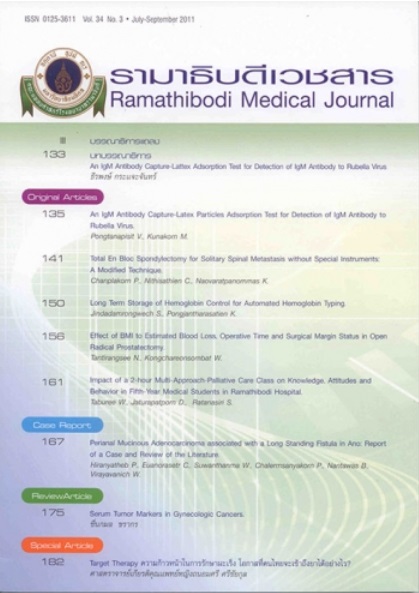An IgM Antibody Capture-Lattex Particles Adsorption Test for Detection of IgM Antibody to Rubella Virus
Keywords:
Rubella IgM, Lattex particles adsorption, ELISAAbstract
Test for IgM specific antibody to rubella is useful for diagnosis of rubella infection. Screening of pregnant woman for rubella IgM is used for prevention of congenital rubella infection in newborns. Although enzyme-liked immunosorbent assay (ELISA) is the widely accepted method, its high cost might be the obstacle for users in developing area. For this reason, we introduced a simple and inexpensive IgM antibody capture-latex particles adsorption test (MAC-LA) for detection of IgM antibody to rubella virus. The test correlated well with the commercial IgM-ELISA test kit (Spearman’s rank correlation coefficient = 0.87, p < 0.001). All 44 positive sera by IgM EIA were also positive by the MAC-LA method. Sera from acute apparent rubella showed rising rubella IgM which was detected as early as 2-3 days after onset of rash as determined by both methods. The MAC-LA also yielded high specificity when it showed negative results in all 134 sera from pregnant women and 20 rheumatoid factor positive sera, which were negative by the IgM-ELISA. With its simplified technique and reasonable cost, this sensitive and specific test is suitable for large scale screening of rubella IgM antibody.
References
Gregg NM. Congenital cataract following German measles in the mother. Trans Ophthalmol Soc Aust. 1941;3:35-46.
Drabu YJ, Walsh B, Huber TJ, Schlesinger P, Vijerathnam S, Hicks L. Maternal rubella: one problem in diagnosis and another in prevention. Lancet. 1987;2(8558):561-2. doi:10.1016/s0140-6736(87)92938-2.
Gilbert J, Kudesia G. Fetal infection after maternal reinfection with rubella. BMJ. 1989;299(6709):1217. doi:10.1136/bmj.299.6709.1217-b.
Enders G. Serologic test combinations for safe detection of rubella infections. Rev Infect Dis. 1985;7 Suppl 1:S113-22. doi:10.1093/clinids/7.supplement_1.s113.
Echevarría JM, Sáinz C, De Ory F, Nájera R. Evaluation of commercial methods of enzyme immunoassay (EIA) for the measurement of rubella-specific IgM. J Virol Methods. 1985;11(3):177-87. doi:10.1016/0166-0934(85)90106-5.
Gerna I, Zannino M, Revello MG, Petruzzelli E, Dovis M. Development and evaluation of a capture enzyme-linked immunosorbent assay for determination of rubella immunoglobulin M using monoclonal antibodies. J Clin Microbiol. 1987;25(6):1033-8.
Seppänen H. Development of a highly specific and sensitive rubella immunoglobulin M antibody capture enzyme immunoassay that uses enzyme-labeled antigen. J Clin Microbiol. 1990;28(4):719-23.
Krech U, Wilhelm JA. A solid-phase immunosorbent technique for the rapid detection of rubella IgM by haemagglutination inhibition. J Gen Virol. 1979;44(2):281-6. doi:10.1099/0022-1317-44-2-281.
Goldwater PN, Banatvala JE. Solid-phase immunosorbent haemadsorption (SPIHAd): a new, rapid and simple test for rubella-specific IgM. J Virol Methods. 1981;2(6):341-7. doi:10.1016/0166-0934(81)90057-4.
Cordoba P, Nates S, Mahony J, Zapata M. Kinetics of rubella-specific IgM antibody response in postnatal rubella infection. J Virol Methods. 1991;34(1):37-43. doi:10.1016/0166-0934(91)90119-k.
Echevarria JM, de Ory F, Najera R. Fluoroimmunoassay for detection of rubella-specific immunoglobulin M: comparison with indirect enzyme immunoassay and mu-chain capture. J Clin Microbiol. 1985;22(3):428-34.
Simor AE, Chua R, Low DE. Evaluation of a new latex test and a new enzyme immunoassay for determination of rubella immunity. J Clin Microbiol. 1988;26(8):1582-3.
Rosner B. Fundamentals of Biostatistics. 3rd ed. Boston, MA: PWS-Kent; 1990:450-5.
Salonen EM, Vaheri A, Suni J, Wager O. Rheumatoid factor in acute viral infections: interference with determination of IgM, IgG, and IgA antibodies in an enzyme immunoassay. J Infect Dis. 1980;142(2):250-5. doi:10.1093/infdis/142.2.250.
Briantais MJ, Grangeot-Keros L, Pillot J. Specificity and sensitivity of the IgM capture immunoassay: studies of possible factors inducing false positive or false negative results. J Virol Methods. 1984;9(1):15-26. doi:10.1016/0166-0934(84)90079-x.













